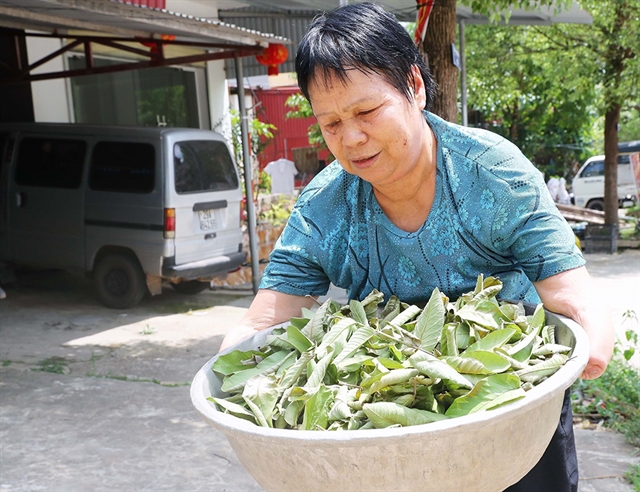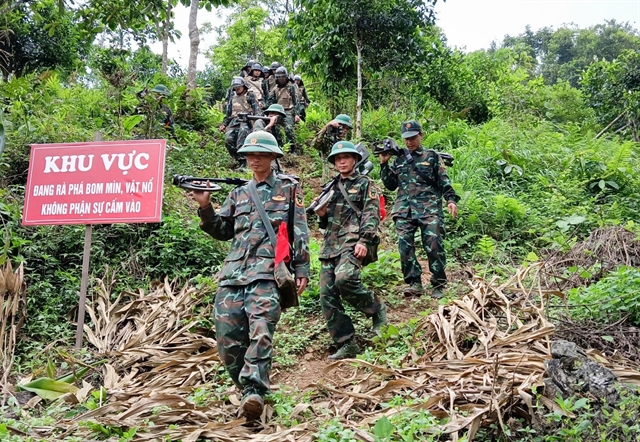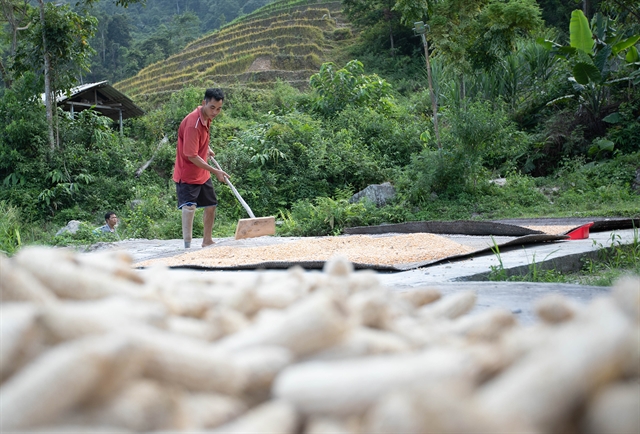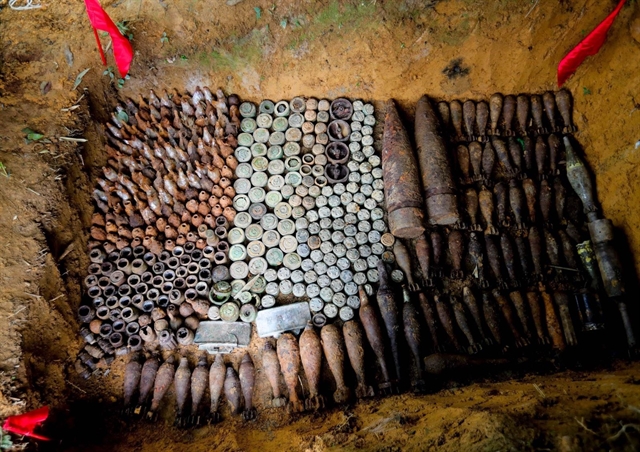 Society
Society

 |
| Vinh Thị Nhọt loses two hands while trying to cultivate on the land contaminated with bombs, mines, and unexploded ordnance (UXO) in her hometown in Yên Khoái Commune, Lộc Bình District in northern Lạng Sơn Province. – VNA/VNS Photo |
HÀ NỘI – After 31 years, Vinh Thị Nhọt, a 65-years-old woman in a small village in northern Lạng Sơn Province is still haunted by the sound of an exploding mine.
The Nùng ethnic woman lost both her hands while trying to cultivate land contaminated with unexploded ordnance (UXO) in her hometown in Yên Khoái Commune, Lộc Bình District.
The accident happened to Nhọt on a chilly morning in the winter of 1992 when she left her house to collect firewood and pick vegetables on Hill 424. This place was still littered with bombs, mines, and explosive materials from the war. The authorities and the military had repeatedly warned people of the dangers.
"I felt like I could have died right then!" she said.
Nguyễn Thị Hương, who lived next to Nhọt's house, was also a victim of bombs and mines.
Hương recounted that she had the accident in the middle of February 1994. She was working on a plot of land that was meant to have been cleared of mines. Unfortunately, she stepped on a mine, which resulted in the loss of one of her legs.
"Everything was spinning. After 55 days of treatment at the hospital, I returned home. My two children didn't want to come near me. I was in immense pain, and life was full of difficulties,” she recalled.
In Thanh Thủy Commune, Vị Xuyên District in northern Hà Giang Province, Triệu Văn Nguyên, a Dao ethnic man lost his right leg after stepping on a mine while clearing land for cultivation.
Pointing towards the mountain range at the high point 1509, the 44-year-old man said there were still many unexploded mines left there.
"My wife and I want more land for cultivation, but we are afraid to go there because of the uncleared mines," he said.
Chairwoman of Thanh Thủy Commune People's Committee Nguyễn Thị Tuyên said Thanh Thủy Commune was one of the localities that suffered the most during the war, with much UXO left in the area.
Over 50 people in the commune have been injured and suffered disabilities due to UXO while farming or herding livestock.
Tuyên said the commune is covered by hills and mountains and interspersed with valleys, making it great for agricultural and forestry development. Local people planted tea, medicinal herbs, and high-value fruit trees.
However, she said, the potential of the land has not been fully tapped. Although the military has cleared over 1,000 hectares of contaminated land in the commune in recent years, the area of landmines and other explosive remnants of war remained substantial.
A recent report by the National Steering Committee for Overcoming the Consequences of Chemical and Explosive Remnants of War showed that the estimated number of remaining UXO in Việt Nam is estimated to be around 800,000 tonnes, affecting over 6.1 million hectares, accounting for over 18 per cent of the country’s total area.
Even sappers, who oversaw deactivating bombs and mines, have become UXO victims.
Lieutenant Lý Đình Hiếu, a soldier at the Military Medical Station of the Engineer Brigade 239, accidentally fell onto an unexploded mine during a clearance mission at the border area in Tràng Định District in Lạng Sơn Province in December 2013.
He lost half of his right leg, becoming a severely disabled veteran at the age of 21.
Figures from the committee showed that over 2,000 officers and soldiers sacrificed or were injured while performing mine clearance tasks throughout the country.
Revival of contaminated land
Lieutenant Colonel Phạm Văn Huỳnh, deputy chief and chief of staff of Engineer Brigade 239 stated that the brigade has established teams to clear thousands of hectares of contaminated land as part of the National Steering Committee for Overcoming the Consequences of Chemical and Explosive Remnants of War in the period of 2010-2025.
Many 'dead lands' that were once plagued by bombs and mines have now been revived thanks to the contributions of the sappers, he said.
The border districts of Lạng Sơn and Hà Giang, which used to be heavily affected by UXO, have gradually been revived.
 |
| Officers and soldiers from 319 Bomb, Mine and Explosive Ordnance One Member Ltd Company have detected, handled and collected bombs, mines and explosives in Vị Xuyên and Quản Bạ districts in Hà Giang Province. – VNA/VNS Photo |
Trịnh Văn Tuấn, residing in Yên Khoái Commune, Lộc Bình District in Lạng Sơn Province said 15 years ago, his three-hectare hill was filled with deep bomb and mine craters.
After the Engineering Corps cleared hundreds of thousands of unexploded mines and handed them over to the local authorities, Tuấn’s family was given more than three hectares of hill land to plant pine trees for resin.
Since 2012, he has planted nearly 5,000 pine trees, and they have now reached the stage of resin harvesting. Tuấn said he expected each pine tree to yield about six kilogrammes of resin per year.
At current prices, one kilogram of pine resin fluctuated between VNĐ30,000 - 35,000, potentially bringing him hundreds of millions of đồng.
 |
| A farmer who lost his right leg due to bombs and mines dries corn on the clear land he was provided for agricultural cultivation. – VNA/VNS Photo |
Chairwoman of Yên Khoái Commune’s People’s Committee Hoàng Thị Giang said effective mine clearance efforts have provided local people with land for agricultural production, afforestation, and timber exploitation.
"The average income of local people is currently about VNĐ49 million per year. The recent allocation of over 10 hectares of clean land to local people from the mine clearance programme has helped them increase their income,” she said.
At the Nậm Xá resettlement area in Đội Cấn Commune, Tràng Định District, Vi Thị Thơm, a Tày ethnic woman, recalled the time when she received three hectares of land left by their parents-in-law but left it abandoned as it was contaminated with UXO.
In 2015, the provincial People’s Committee decided to clear the land and build it into a resettlement area. Thơm, as well as other 18 households, moved to live here in 2018.
On the clear land, she planted thousands of cinnamon and aquilaria trees, as well as cultivated rice.
"My family started planting cinnamon in 2020 and they have developed quite well. If all goes well, we can harvest in about five years. Each crop can yield an income of about VNĐ300 million," she said.
Major Lương Văn Tuấn, Deputy Commander of the Military Command of Tràng Đinh District revealed that the military has successfully deactivated UXO on 2,000 hectares of land. There were still over 3,000 hectares of contaminated land in the district.
“Many poor households have improved their lives and escaped poverty thanks to the land provided for their economic development. The Engineering Corps will continue to carry out mine clearance tasks in the future,” he said.
 |
| Bombs and explosives of various types are collected in Hà Giang Province. – VNA/VNS Photo |
In Hà Giang Province, the Command of Military Zone 2 has set a goal to clear 1,500 hectares of land in Vị Xuyên and Quản Bạ districts by 2026. Since early March, more than 530 officers and soldiers have deactivated bombs, mines, and other explosives on 400 hectares of land.
Colonel Lại Tiến Giang, Commander of the Military Command of Hà Giang Province, stated that the total area of contaminated land reached over 90,000 hectares. More than 12,000 hectares have been cleared, but there is still much work to be done.
The military is currently focusing on 110 hectares in Thanh Thủy Commune in Vị Xuyên District to provide clean land to local people for agricultural cultivation, he said.
Vice Chairman of the provincial People's Committee Trần Đức Quý said that Hà Giang has identified the two key tasks of mine clearance and the search and gathering of martyrs’ remains.
"Clearing bombs and mines minimises the risks of casualties and accidents for ethnic minority communities in border areas and provides them with cultivated land. This will gradually help them escape poverty," he said. – VNS




